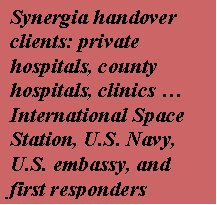Handover in healthcare delivery is any quick information exchange that transmits key
information on the patient, and, usually, also transfers some or all responsibility for the patient.
Handover occurs in several different contexts, and is sometimes referred to as handoff, signout, or
report. Handover offers a vivid example of the kinds of
problems Synergia helps
organizations solve, and illustrates the many ways our methods and technologies can help.
 We have worked on handover for most of the life of the company. Handover is an important element in
the management of almost all complex operations, yet very few organizations see it as a skill to be
mastered. Fewer still train for effectiveness. Handover is generally treated as winding up and reporting on
‘the real work’ that has just concluded and that will begin again after the handover is complete.
We have worked on handover for most of the life of the company. Handover is an important element in
the management of almost all complex operations, yet very few organizations see it as a skill to be
mastered. Fewer still train for effectiveness. Handover is generally treated as winding up and reporting on
‘the real work’ that has just concluded and that will begin again after the handover is complete.
Instead, to be effective, handover needs to be conducted as the central and essential mechanism
to ensure coordinated team activity now and going forward. It is creating shared understanding about
the clinical picture and what it means for team activity.
Handover creates mutual understanding going forward. It also repairs breaks in understanding and
coordination within the team, and can ensure that information that may become relevant at some later
stage of care is preserved for use. Our work has revealed that there are three key kinds of situations
for which coordination is threatened - situations in which a particularly effective handover is
required. This appears to be a universal aspect of any complex domain that requires handovers.
Caregivers can learn to recognize they are in these situations.
Synergia maps key healthcare delivery activities, and the way they depend on handover and other
forms of communication. (See key JCAHO data on the
importance of
communication here.) Synergia gives organizations a clear picture of their handover processes,
and a diagnosis of flaws that create safety risks or lengthen the patient's stay. On this basis we work
with clients to define and implement remedies, such as the following:
-
Training in highly effective handover - fulfills and goes beyond JCAHO requirements for handover,
and addresses ways flawed handovers create risk and inefficiency.
-
Handover as a special context, and as a complex of skills that create coordination and repair breaks
-
Effective communication: pre-planning, paraphrase, critical dialogue, conflict resolution, joint exploration
-
The distinction between clinical information and coordination information
-
Recognition of the categories of clinical and problem-solving situations in which much richer communication
is required.
-
Developing approaches to rounds so that they produce and preserve key information for later handovers -
delivered in training, kinds of records to keep and disseminate, and as improved roles and role relationships
-
Working with the client to design and introduce new methods and new ways of representing key information,
based on results of mapping client handover practices. As needed, create or advise on technology to store
and present this information (e.g., upgrade or augment client EMR).
-
Developing support technology or training in new practices, to amplify and sustain the benefits of larger
change strategies that contain handover as a component
[Contact Synergia for more information on general features of handover and
associated organizational complexities.]